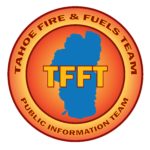Fire Prevention Tips for This Summer at Lake Tahoe
June 25th, 2019PRESS RELEASE
Tahoe Fire and Fuels Team
For Immediate Release
June 25, 2019
Fire prevention tips for this summer at Lake Tahoe
Contact: USDA Forest Service, Lisa Herron (530) 543-2815
SOUTH LAKE TAHOE, Calif. – Summer is officially underway and recreational activities are in full swing in the Lake Tahoe Basin. The Tahoe Fire and Fuels Team (TFFT) would like to take this opportunity to remind visitors and residents that wildfires pose a serious threat to Lake Tahoe neighborhoods, communities and forests and we need help to prevent unwanted fires this summer. Whether backpacking, camping, hiking or participating in some other activity in the forest, please keep the following tips in mind to reduce the threat of catastrophic wildfire.
Fireworks
The Fourth of July holiday is right around the corner. All fireworks, including sparklers and firecrackers, are illegal in the Tahoe Basin because of the wildfire danger they pose to our communities and forests. Please leave fireworks to the professionals and attend one of the amazing public shows around the lake this July 4 holiday.
Campfires
Sadly, illegal campfires continue to be the leading cause of unwanted wildfires here in the Tahoe Basin. Please remember, campfires and portable charcoal grills are only allowed within metal fire rings and/or standup grills provided in designated campgrounds. Campfires and portable charcoal grills are not allowed on National Forest beaches, in Desolation Wilderness, Meiss Country, along Genoa Peak Road and the Tahoe Rim Trail or in any existing rock fire rings. Gas stoves are allowed in all areas with a free, valid California Campfire Permit available online at preventwildfireca.org/Campfire-Permit/.
Additionally, during periods of high fire danger, campfires in designated areas may be restricted. Before building a campfire, always check with local fire districts or the USDA Forest Service office in South Lake Tahoe to find out if restrictions are in place.
Learn to properly build, maintain and extinguish campfires and always keep a bucket of water and a shovel nearby. Select an open location away from trees and overhanging tree branches, logs, brush or dry vegetation. Keep the fire small and be sure that all combustible materials fit within the fire ring. Never leave the campfire unattended and be sure to completely extinguish it before leaving, using the Soak, Stir and Feel method. Soak the fire with water and stir
thoroughly. Using the back of your hand, feel for any remaining heat. Repeat as needed until the fire is completely extinguished and no hotspots remain.
Sparks
Did you know that most wildfires are caused by human activity? Things like lawn equipment, debris burning, target shooting and vehicles can all cause sparks that may ignite a wildfire when used under the wrong conditions.
Lawn mowers, weed-eaters, chain saws, grinders, welders, tractors and trimmers can all spark a wildland fire when used during hot, dry and windy weather. This type of equipment should be operated before 10 a.m. when the humidity is higher and never when it’s excessively dry, hot and/or windy.
Residential burning is only allowed under specific conditions and in certain areas with a valid permit. Check with local fire districts to determine if burning is allowed in your area and if restrictions are in place.
Target shooting under hot, dry conditions can spark a fire. When target shooting, choose an area free of dry vegetation and avoid shooting on hot, windy days. Use proper targets, such as clay pigeons and avoid shooting at metal targets or rocks.
Vehicles should be properly maintained with nothing dragging on the ground. Dragging chains or any other type of metal can cause sparks that may ignite a wildfire. Practice proper towing by using appropriate safety devices and hitches that secure chains or other equipment. Avoid driving or parking on dry vegetation as hot exhaust pipes, mufflers and catalytic converters may ignite grasses and other vegetation. Properly maintain brakes and tires as exposed wheel rims and brakes worn too thin can cause sparks.
Contact information for your local fire district is available at tahoe.livingwithfire.info/getinformed/find-your-fire-district/. The Forest Service may be reached at 530-543-2600, Monday through Friday from 8 a.m. until 4:30 p.m. and is located at 35 College Drive, South Lake Tahoe,
CA 96150.
The mission of the TFFT is to protect lives, property and the environment of the Lake Tahoe Basin from wildfire. To accomplish that, the TFFT needs everyone’s help and cooperation. Learn more about fire prevention and campfire safety at tahoe.livingwithfire.info, smokeybear.com, preventwildfireca.org and/or readyforwildfire.org.
About the Tahoe Fire and Fuels Team
The Tahoe Fire and Fuels Team (TFFT) consists of representatives of Tahoe Basin fire agencies, CAL FIRE, Nevada Division of Forestry and related state agencies, University of California and Nevada Cooperative Extensions, the Tahoe Regional Planning Agency, the USDA Forest Service, conservation districts from both states, the California Tahoe Conservancy and the Lahontan Regional Water Quality Control Board. Our Mission is to protect lives, property and the environment within the Lake Tahoe Basin from wildfire by implementing prioritized fuels reduction projects and
engaging the public in becoming a Fire Adapted Community.
For more information, visit tahoe.livingwithfire.info

